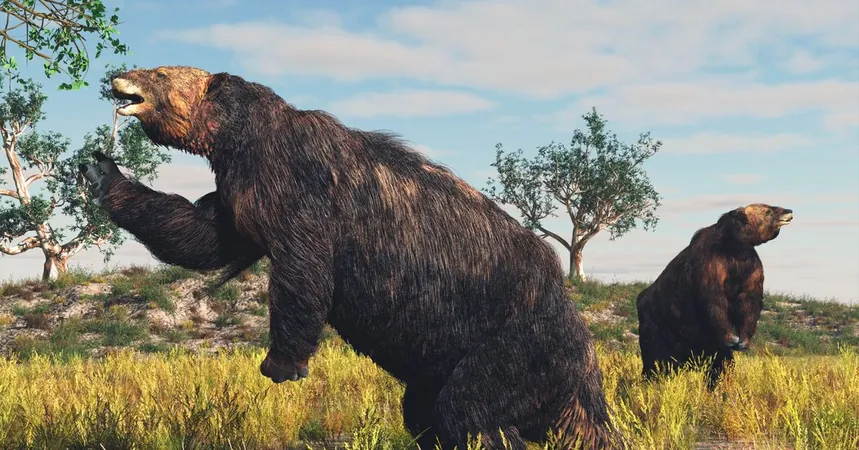
Uncovering the Furry Mysteries of Giant Ground Sloths: What Did They Really Look Like?
2025-04-04
Author: Chun
In a groundbreaking study published in The Journal of Mammalian Evolution, scientists shed light on the fascinating world of giant ground sloths, a group of enormous mammals that once roamed from South America all the way to the fringes of Canada. While today’s tree-dwelling sloths are relatively small and furry, their colossal ancestors varied greatly in size, with some species approaching the size of modern-day elephants.
Fossil evidence suggests that while some ground sloths were densely furred, questions still lingered about whether other species evolved to have significantly less hair. This new research offers a deeper understanding of their appearance and thermoregulation, shedding light on whether they were fluffy giants or more stream-lined creatures.
Methodology and Research Team
The methodology behind identifying the physical characteristics of these extinct mammals is complex. Ground sloths thrived in wildly diverse ecosystems, ranging from tropical jungles to frigid mountain ranges. Among these ancient giants were the megatheres, namely Megatherium and Eremotherium, which stand out as some of the largest terrestrial mammals to have ever existed.
The research team, including notable figures like Robert Eagle and Aradhna Tripati from UCLA, employed a cutting-edge analysis technique focusing on fossilized teeth. By measuring the isotopic composition in the teeth of three megatheres and two smaller species, they successfully estimated the sloths' core body temperatures. The astonishing discovery revealed that these gigantic creatures had a lower body temperature—between 84 and 89 degrees Fahrenheit—than that of most large mammals alive today.
3D Modeling and Thermal Comfort Zone
Three-dimensional computer models created by paleoartists assisted the researchers in estimating the body volume and surface area of these sloths. Factors such as humidity, wind speed, and sunshine exposure varied across their habitats. The principal aim of this research, led by Michael Deak from Penn State Shenango, was to identify a 'thermal comfort zone' for precisely how these animals would have managed their body heat.
Diverse Fur Coverage
Among their findings, Megatherium exhibited a preference for a thick, dense coat of fur across various environments. Modeling suggested that any attempt to represent this sloth with sparse, elephant-like hair might imply it would encounter constant cold-stress, shedding light on how crucial fur was to its survival.
On the other hand, Eremotherium, a slightly larger relative, presented a more intriguing narrative. The team proposed that this species might have experienced fluctuations in its fur coverage depending on its habitat. In the colder Andes Mountains, a thick layer of fur would have been a necessity, whereas warmer climates might have allowed for more sparse fur. Evidence suggests that Eremotherium could have adapted its fur coat throughout the year, shedding in the warmer months while growing thicker in winter.
Energy Conservation Strategies
The study highlights parallels between the energy conservation strategies of modern tree sloths and those of their monstrous ancestors, as noted by researcher Michael Butcher from Youngstown State University. Ground sloths, despite their larger sizes, likely exhibited similar behaviors aimed at maintaining energy efficiency.
Expert Opinions
Natural history conservator Mariana Di Giacomo from the Yale Peabody Museum, though not involved in the study, praised the findings but expressed a desire for broader sampling across various regions to enhance the study's robustness. She emphasized that an expanded database from colder regions, such as Argentina or Chile, could have provided a more comprehensive understanding of the species' adaptations.
In a similar vein, paleontologist Greg McDonald underscored the value of the isotope data as a solid foundation for the study. The synthesis of information from multiple sources, he noted, reinforced the findings, lending credence to the researchers' conclusions about the crucial role of fur in these ancient mammals' existence.
Conclusion
As we delve deeper into our planet’s history, the revelations about giant ground sloths not only capture our imagination but open new avenues for understanding how these magnificent creatures thrived across diverse climates millions of years ago! Stay tuned for more exciting insights into the prehistoric world!


 Brasil (PT)
Brasil (PT)
 Canada (EN)
Canada (EN)
 Chile (ES)
Chile (ES)
 Česko (CS)
Česko (CS)
 대한민국 (KO)
대한민국 (KO)
 España (ES)
España (ES)
 France (FR)
France (FR)
 Hong Kong (EN)
Hong Kong (EN)
 Italia (IT)
Italia (IT)
 日本 (JA)
日本 (JA)
 Magyarország (HU)
Magyarország (HU)
 Norge (NO)
Norge (NO)
 Polska (PL)
Polska (PL)
 Schweiz (DE)
Schweiz (DE)
 Singapore (EN)
Singapore (EN)
 Sverige (SV)
Sverige (SV)
 Suomi (FI)
Suomi (FI)
 Türkiye (TR)
Türkiye (TR)
 الإمارات العربية المتحدة (AR)
الإمارات العربية المتحدة (AR)